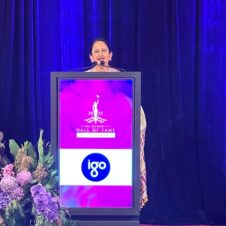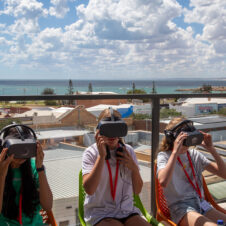A paper published in Science, & involving several ICRAR researchers, has won the prestigious AAAS Newcomb Cleveland Prize.
Every year hundreds of ground-breaking research papers are published in the journal Science, but only one is selected for the prestigious AAAS Newcomb Cleveland Prize, the association’s oldest award. The best paper is chosen based on the quality of the scholarship, innovation, presentation, likelihood of influencing the field, and wider interdisciplinary significance.
ICRAR-Curtin’s Dr Clancy James said the amazing result was due to the vision of a few and the hard work of many.
The winning paper, ‘A single fast radio burst localized to a massive galaxy at cosmological distance‘, was led by Dr Keith Bannister from CSIRO, with ICRAR-Curtin co-authors Freya North-Hickey, Wayne Arcus, Dr Clancy James, adjunct Prof Ron Ekers and the late A/Prof Jean-Pierre Macquart, and Dr Richard Dodson based at ICRAR-UWA.
Fast radio bursts (FRBs) are brief radio emissions from distant astronomical sources, and until recently there have been more theories about FRBs than there have been FRBs detected!
The prize-winning paper described how ASKAP was able to determine where a fast radio burst came from for the first time, and with incredible precision. The team determined which galaxy the burst originated in and also where it came from within that galaxy.
The host galaxy was found to be three and a half billion light years away and not particularly special, ruling out that FRBs are produced by supermassive black holes, or come exclusively from dwarf galaxies undergoing a ‘burst’ of star formation.
This result laid the groundwork for studying the missing matter in the Universe, which astronomers thought was sparsely spread between galaxies and invisible to traditional astronomical observations.
What causes FRBs is one of the largest unsolved mysteries for today’s astronomers. ICRAR-Curtin PhD candidate Freya North-Hickey was an honours student when she worked on this paper and her current thesis is a direct consequence of the monumental change localising FRBs made to the field.
Next, Freya says the team will carry out extensive investigations into FRB host galaxies.
“I now conduct detailed follow-up observations of FRB host galaxies, trying to solve the mystery of what causes these extremely bright and energetic bursts. I have a very exciting few years ahead of me in this field,” she said.
About the Prize
The AAAS Newcomb Cleveland Prize, supported by The Fodor Family Trust, was established in 1923 with funds donated by Newcomb Cleveland of New York City and was originally called the AAAS Thousand Dollar Prize. It is now known as the AAAS Newcomb Cleveland Prize, and its value is US$25,000. In addition to the prize funds, the winner receives a commemorative plaque, complimentary registration, and reimbursement for reasonable travel and hotel expenses to attend the AAAS Annual Meeting in order to accept the prize.
This award was presented at the 2021 AAAS Annual Meeting, which is being held virtually 8-11 February 2021.

